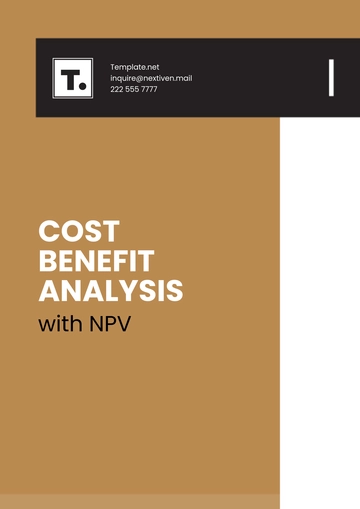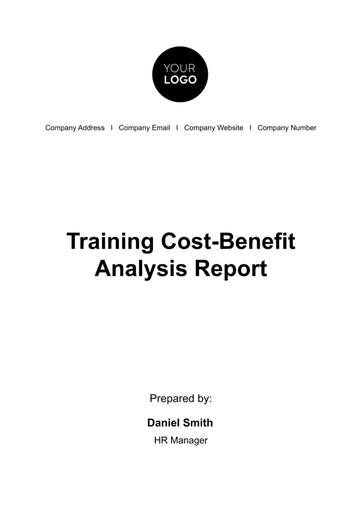Free Detailed Financial Investment Analysis

I. Executive Summary
The analysis of our financial investments presents a comprehensive overview of our portfolio, emphasizing key insights derived from rigorous examination. Our diverse investment strategy, marked by strategic partnerships and financial expertise, aligns seamlessly with organizational goals, contributing to a resilient and adaptive investment approach. The SWOT analysis highlights inherent strengths, addresses weaknesses, explores opportunities, and mitigates threats, providing a strategic roadmap for the future. The analysis underscores our commitment to legal compliance, ethical standards, and proactive risk management, ensuring the stability and sustainability of our investments.
Strategic fit is evident in the alignment of our investments with overarching organizational objectives, emphasizing adaptability to market changes and robust risk mitigation. Recommendations focused on portfolio diversification, technological integration, strategic market expansion, continuous regulatory monitoring, and enhanced competitive positioning aim to propel our financial investments towards sustained growth and competitiveness. In conclusion, this executive summary encapsulates the strategic essence of our financial investments, emphasizing their alignment with organizational objectives and outlining actionable recommendations for future success.
II. Investment Overview
A. Investment Description
Our investment strategy centers around acquiring a diverse portfolio of residential real estate properties within urban markets. This includes both single-family homes and multi-unit residential complexes. Our primary objective is to leverage the increasing demand for rental housing in targeted metropolitan areas.
B. Company's Investment Objectives
Capital Appreciation
We aim to achieve substantial capital appreciation over the investment horizon through strategic property acquisitions and market-driven appreciation.
Income Generation
Our goal is to generate a consistent stream of rental income by leasing residential units at competitive market rates.
Risk Mitigation
We actively implement risk mitigation strategies to safeguard our investment against potential market downturns and economic uncertainties.
III. Market Analysis
A. Macro-Economic Trends
GDP Growth and Economic Stability
Our macro-economic analysis indicates a stable economic environment with consistent GDP growth, providing a favorable backdrop for our real estate investments.
Interest Rate Environment
The current low-interest rates are advantageous to our real estate ventures, reducing borrowing costs and potentially enhancing our investment returns.
B. Real Estate Market Dynamics
Market Demand
Our comprehensive analysis of the real estate market showcases a sustained demand for rental properties, driven by factors such as population growth, urbanization, and lifestyle preferences.
Competitive Landscape
We recognize the mix of institutional and individual investors in the competitive landscape. Our analysis identifies key competitors and their strategies within our target markets.
C. Regulatory Landscape
Zoning and Land Use Regulations
We conduct a thorough examination of zoning regulations and land use policies to outline permissible uses and potential restrictions on property development.
IV. Financial Statements Analysis
A. Income Statement Analysis
The table below provides a breakdown of key income statement components:
Category | Amount |
Revenue | $5,200,000 |
Cost of Goods Sold (COGS) | |
Gross Profit | |
Operating Expenses | |
Net Income |
Understanding the dynamics presented in the table is crucial for evaluating the financial health of our operations. Positive net income signifies profitability, reflecting revenue exceeding the cost of goods sold and operational expenses. The gross profit highlights the effectiveness of our revenue generation and cost management strategies. By analyzing operating expenses, we can identify areas for potential optimization, enhancing overall profitability. Monitoring trends in revenue and gross profit over time aids in assessing the growth trajectory and market competitiveness of our company.
B. Balance Sheet Analysis
The table below delineates key balance sheet elements:
Category | Amount |
Assets | $12,000,000 |
Liabilities | |
Equity |
This analysis offers insights into our financial stability and solvency. The balance between assets and liabilities is critical, as positive equity signifies our company's net worth and shareholder value. Monitoring changes in assets and liabilities provides a holistic view of our financial position, guiding strategic decision-making. Moreover, a healthy balance sheet ensures that our company is well-positioned to meet both short-term and long-term obligations, contributing to sustained business operations and growth.
C. Cash Flow Statement Analysis
The table below provides a breakdown of key cash flow statement components:
Category | Amount |
Operating Activities | $3,000,000 |
Investing Activities | |
Financing Activities | |
Net Cash Flow |
This analysis is pivotal for assessing our company's liquidity and ability to meet short-term obligations. Positive cash flow from operating activities ensures ongoing business operations, while careful management of investing and financing activities informs strategic decision-making. A positive net cash flow indicates our company's capacity to generate surplus cash, supporting future investments, debt repayment, or distribution to shareholders. Regular monitoring of these cash flow dynamics is essential for maintaining financial resilience and flexibility in a dynamic business environment.
V. Risk Assessment
A. Market Risks
Economic Conditions
The risk of economic downturns affecting demand for real estate and rental properties. Mitigation involves scenario planning, ensuring financial flexibility, and adjusting investment strategies based on economic indicators.
Interest Rate Fluctuations
Fluctuations in interest rates can impact borrowing costs and the affordability of mortgages, affecting property demand. Hedging strategies, variable rate management, and prudent financial planning are employed to mitigate this risk.
Market Trends
Rapid changes in market trends pose a risk to the value and demand for our properties. Staying attuned to market dynamics, diversifying the portfolio, and proactive market research help in mitigating risks associated with evolving trends.
B. Operational Risks
Property Management
Risks associated with property management, including tenant turnover, maintenance issues, and regulatory compliance. Robust property management protocols, regular inspections, and tenant relations initiatives are implemented to mitigate these risks.
Legal and Regulatory Compliance
Adherence to local, state, and federal regulations is critical. Regular legal reviews, compliance audits, and staying abreast of regulatory changes are essential components of our risk mitigation strategy.
Technological Risks
Rapid advancements in property technology pose risks if not integrated effectively. Constantly assessing and adopting relevant technologies, ensuring cybersecurity measures, and staying technologically agile help mitigate operational risks.
C. Financial Risks
Debt and Leverage
The risk associated with debt obligations and leverage, particularly in fluctuating market conditions. Prudent debt management, stress testing, and maintaining a healthy debt-to-equity ratio are integral to mitigating this risk.
Liquidity Challenges
Risks associated with inadequate liquidity to meet financial obligations. Ongoing cash flow analysis, contingency planning, and maintaining adequate reserves are strategies employed to address potential liquidity challenges.
Market Volatility
Fluctuations in financial markets can impact the valuation of our assets. Implementing risk hedging strategies, diversifying investment portfolios, and staying vigilant to market trends contribute to mitigating financial risks.
D. Strategic Risks
Market Positioning
The risk associated with the competitive positioning of our properties and the overall investment strategy. Regular market analysis, adapting strategies to evolving market conditions, and strategic partnerships contribute to minimizing this risk.
Sustainability and ESG Risks
Risks related to environmental, social, and governance factors. Integrating sustainability principles, adhering to ESG standards, and regular impact assessments are essential in mitigating these risks.
Strategic Decision Risks
Risks associated with strategic decisions impacting the overall success of the investment. Conducting thorough risk assessments before major decisions, scenario planning, and ensuring alignment with long-term goals help mitigate strategic risks.
VI. Return on Investment (ROI) Analysis
The table below provides a snapshot of our analysis:
Category | Initial Investment | Net Profit | ROI |
Residential Real Estate | $2,000,000 | $500,000 | 25% |
The data above outlines the initial investment, net profit generated, and the corresponding ROI percentage for various projects. These metrics serve as key indicators of the efficiency and success of our investment endeavors. A higher ROI signifies a proportionally greater return relative to our initial investment, reflecting positively on the financial performance of each investment category.
VII. Cash Flow Projections
The table below presents the projections for the next fiscal year:
Category | Operating Activities | Investing Activities | Financing Activities | Net Cash Flow |
Residential Real Estate | $1,200,000 | ($800,000) | ($300,000) | $100,000 |
Positive net cash flows indicate the company's ability to pursue future investment opportunities and maintain financial resilience. Additionally, the projections enable us to anticipate potential liquidity challenges and strategically allocate resources. This forward-looking analysis is crucial for ensuring financial stability and supporting the sustained growth of our investment portfolio.
VIII. Regulatory and Compliance Review
A. Regulatory Compliance
Legal Adherence
Ensuring strict adherence to local, state, and federal regulations is pivotal in our commitment to legal integrity. Regular legal reviews and audits safeguard against non-compliance risks, reinforcing our dedication to operating within established legal frameworks.
Industry-Specific Regulations
Vigilant adherence to industry-specific regulations is central to risk mitigation in our real estate and financial investments. We stay agile in adapting policies and practices to changes in regulations, ensuring sustained compliance and resilience in a dynamic market.
Ethical Standards
Upholding the highest ethical standards is embedded in our corporate culture. We establish and communicate clear ethical guidelines, fostering a workplace environment that prioritizes integrity and ethical conduct at every level.
B. Compliance Monitoring and Reporting
Monitoring Protocols
Robust monitoring protocols are in place to ensure continuous compliance with regulatory requirements. Regular checks and assessments form a proactive approach to identify and address potential compliance issues promptly.
Reporting Mechanisms
Our commitment to maintaining open channels for employees to report concerns fosters a culture of accountability and responsiveness.
Documentation Practices
Thorough documentation of compliance efforts is a cornerstone of our commitment to transparency. Accurate records, including policy updates, training sessions, and audit results, serve as tangible evidence of our dedication to regulatory adherence.
IX. SWOT Analysis
A. Strengths
Diverse Portfolio
Our diverse investment portfolio is a strategic strength, providing a natural hedge against market volatility. This diversity not only mitigates risk exposure but also enhances the overall stability and resilience of our investment holdings.
Financial Expertise
The presence of a highly skilled financial team is a competitive advantage. Our experts, proficient in market analysis, risk assessment, and strategic planning, play a pivotal role in guiding our investments, ensuring financial prudence and sustained success.
Strategic Partnerships
Strategic collaborations with key industry players reinforce our market standing. These partnerships offer not only access to valuable resources but also amplify our market visibility, fostering potential joint ventures and expanding our network within the industry.
B. Weaknesses
Market Sensitivity
Our sensitivity to market fluctuations is a recognized challenge. To address this weakness, we maintain a proactive risk management strategy, adapting swiftly to market changes and implementing measures to mitigate potential financial impacts.
Dependency on External Factors
External factors, such as interest rates and regulatory changes, pose challenges to our investment landscape. Despite this dependence, our adaptive strategies are designed to navigate and minimize the impact of external variables on our financial investments.
Limited Geographic Presence
Our limited geographic presence poses an opportunity for improvement. Strategically expanding into new markets is a priority, offering avenues to diversify our investments and capture emerging opportunities for growth.
C. Opportunities
Emerging Markets
Exploring emerging markets is a strategic growth opportunity. Identifying and entering new markets strategically allows us to capitalize on evolving trends, tap into untapped potential, and diversify our investment portfolio.
Technological Integration
Embracing technological advancements in property management presents an opportunity for operational efficiency. Innovations enable us to streamline operations, enhance customer experiences, and maintain a competitive edge in the dynamic real estate market.
Sustainable Investments
The rising demand for sustainable investments offers a significant opportunity. Incorporating environmental, social, and governance (ESG) principles into our investment strategies aligns with market preferences and regulatory trends, enhancing our market position and attracting socially conscious investors.
D. Threats
Economic Downturns
Economic downturns pose a substantial threat to our financial stability. Proactively implementing contingency plans and robust risk mitigation strategies is crucial to navigate potential downturns effectively and safeguard our investments.
Regulatory Changes
Rapid changes in regulatory landscapes represent an ongoing threat. Continuous monitoring and adaptive strategies are imperative to ensure compliance, minimizing legal risks associated with regulatory changes that may impact our financial investments.
Intense Market Competition
Intense competition in the real estate and investment sectors is a notable threat. To remain competitive, we focus on developing unique value propositions, fostering innovation, and enhancing customer relationships, positioning ourselves as a standout player in the market.
X. Strategic Fit
A. Alignment with Organizational Goals
The analysis reveals a strong alignment between the financial investments and the overall strategic goals of the organization. The diverse portfolio, coupled with strategic partnerships, contributes directly to the achievement of long-term financial objectives.
B. Risk Mitigation and Adaptability
The robust risk mitigation strategies and adaptability to market changes is evident. This alignment ensures that our financial endeavors contribute not only to financial growth but also to the overarching strategic resilience of the organization.
C. Elevated Market Position
The strategic fit is evident in our efforts to elevate our market position through technological integration and sustainability initiatives. These elements align with the broader organizational goals of innovation, operational efficiency, and responsible business practices.
XI. Recommendations
A. Portfolio Diversification
In response to the dynamic nature of financial markets, it is prudent to embrace portfolio diversification strategies. By exploring new emerging markets and incorporating sustainable investments, our portfolio becomes more resilient to market fluctuations. This approach not only aligns with current market trends but also strategically enhances the overall robustness of our investment strategy, providing a shield against unforeseen challenges.
B. Technological Advancements
Embracing technological advancements in property management is essential for staying ahead in the competitive landscape. Integrating innovative technologies not only streamlines operational processes but also positions our organization as an industry leader. This proactive approach ensures not only current operational efficiency but also lays the groundwork for adapting to future changes, fostering a sustained and distinct competitive advantage.
C. Strategic Market Expansion
To address the current limitation of a confined geographic presence, strategic market expansion is recommended. Diversifying our reach into new geographic markets aligns with the overarching opportunity for growth, particularly in emerging markets. This strategic move not only mitigates weaknesses but also opens up avenues for diversification, tapping into previously untapped potential and positioning us for long-term success.
D. Continuous Regulatory Monitoring
In the face of evolving regulatory landscapes, it is imperative to establish robust mechanisms for continuous monitoring. The proactive adaptation to changing regulations ensures ongoing compliance, thereby mitigating legal risks and safeguarding the stability of our financial investments. By staying ahead of regulatory changes, we fortify our position as a responsible and compliant player in the market.
Enhanced Competitive Positioning
To navigate the challenges posed by intense market competition, a strategic focus on enhancing competitive positioning is paramount. This involves a sustained emphasis on unique value propositions, continuous innovation, and effective customer relationship management. By fortifying these aspects, we not only counteract the threats of intense market competition but also solidify our standing in the highly competitive real estate and investment sectors, ensuring long-term success.
XII. Conclusion
In conclusion, the exhaustive analysis has bestowed upon us a profound comprehension of the strengths, weaknesses, opportunities, and threats ingrained in our portfolio. The strategic harmony between our investments and organizational objectives accentuates the coherence guiding our financial pursuits. Bolstering our standing in a constantly evolving market milieu, we've solidified our position through strategic partnerships, adept portfolio management, and an unwavering commitment to ethical standards. The deliberate diversification of our portfolio, coupled with an embrace of cutting-edge technology and astute expansion into burgeoning markets, positions us favorably for sustained success. In the face of regulatory hurdles and intense market rivalries, our proactive and adaptive approach serves as a linchpin, ensuring the resilience of our financial investments and contributing significantly to the overarching triumph of the organization. As we continue to navigate challenges and seize opportunities, our commitment to excellence remains unwavering, propelling us towards a future marked by enduring prosperity.
- 100% Customizable, free editor
- Access 1 Million+ Templates, photo’s & graphics
- Download or share as a template
- Click and replace photos, graphics, text, backgrounds
- Resize, crop, AI write & more
- Access advanced editor
Analyze investments in detail effortlessly with this Detailed Financial Investment Analysis Template from Template.net! This editable and customizable template facilitates a comprehensive analysis of investments. Optimize decision-making, ensuring your investments align with your financial goals. Make analysis easier using the simplicity of our advanced AI Editor Tool! Use it immediately!





























